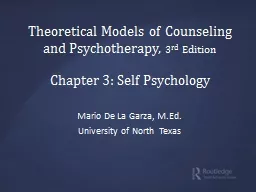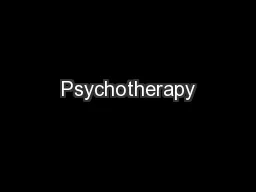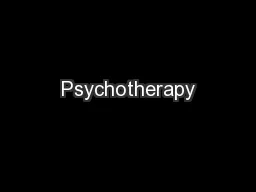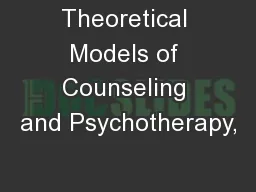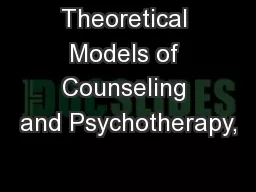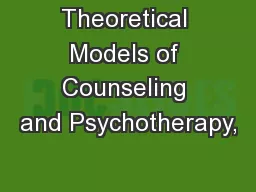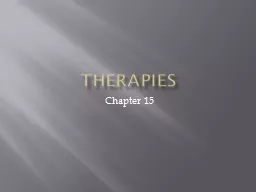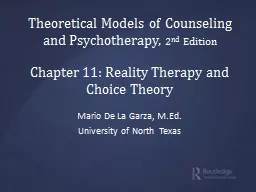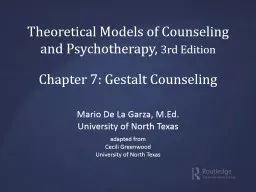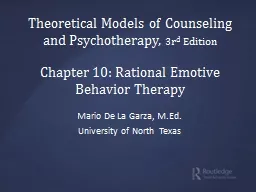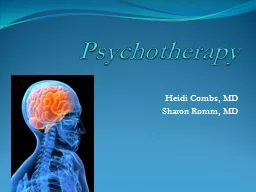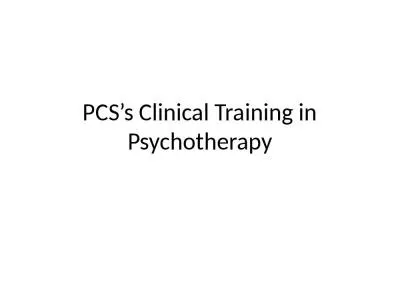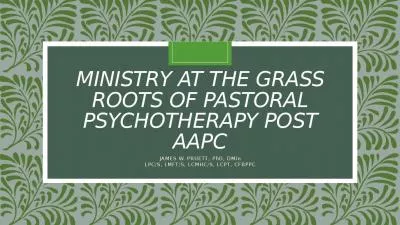PPT-Theoretical Models of Counseling and Psychotherapy,
Author : giovanna-bartolotta | Published Date : 2018-03-16
3 rd Edition Chapter 3 Self Psychology Mario De La Garza MEd University of North Texas Psychodynamic Theories Retain significant similarities to psychoanalysis
Presentation Embed Code
Download Presentation
Download Presentation The PPT/PDF document "Theoretical Models of Counseling and Psy..." is the property of its rightful owner. Permission is granted to download and print the materials on this website for personal, non-commercial use only, and to display it on your personal computer provided you do not modify the materials and that you retain all copyright notices contained in the materials. By downloading content from our website, you accept the terms of this agreement.
Theoretical Models of Counseling and Psychotherapy,: Transcript
3 rd Edition Chapter 3 Self Psychology Mario De La Garza MEd University of North Texas Psychodynamic Theories Retain significant similarities to psychoanalysis Emotions cognitions and behaviors are influenced by psychological processes that are to some degree unconscious. Max Palmer. What is Cognitive Therapy?. First coined by American psychologist Ulric Neisser. Cognition is our mental process, or thoughts. By changing our thoughts, we change our emotions. By changing emotions, we can return to happiness. Helping . Behaviour. We help each other in time of need. Help provided by our friends, relatives, family members. Common man understanding is limited. No guarantee of success . Not scientific. Counselling. . A Patient-Centered, Evidence-Based . Diagnostic and Treatment Process . A Presentation for the Students of Ohio University . Heritage College of Osteopathic Medicine. Kendall L. Stewart, MD, MBA, DFAPA. 3rd. Edition . Chapter 14: Integral Counseling. Mario De La Garza, M.Ed.. University of North Texas. Transpersonal. Transpersonal – beyond the personal; beyond the sense of oneself as a separate entity who functions in the space/time world of earthly existence to achieve individual survival. 3r. d. Edition . Chapter 10: Rational Emotive Behavior Therapy. Mario De La Garza, M.Ed.. University of North Texas. Albert Ellis. The oldest of three children. Struggled with serious kidney problems. 2. nd. Edition . Chapter 12: Constructivist Approaches. Andre Marquis, Ph.D.. University of Rochester. Historical Context. A reaction against the prevailing attitude of narrow empiricism and the search for an objective truth. Psychotherapy can be defined as a process in which a trained professional uses psychological methods to help a person with psychological problems.. Psychological methods can refer to almost any kind of human interaction that is based on a psychological theory. . 2. nd. Edition . Chapter 11: Reality Therapy and . Choice Theory. Mario De La Garza, M.Ed.. University of North Texas. Historical Context. 1950s: mental health professionals began honoring people’s ability to choose and control thoughts, feelings, and behavior. 3rd. . Edition . Chapter 7: Gestalt Counseling. Mario De La Garza, M.Ed.. University of North Texas. adapted from . Cecili. Greenwood. University of North Texas. Founder’s Overview. Frederick “Fritz” . 3r. d. Edition . Chapter 10: Rational Emotive Behavior Therapy. Mario De La Garza, M.Ed.. University of North Texas. Albert Ellis. The oldest of three children. Struggled with serious kidney problems. Psychotherapy Heidi Combs, MD Sharon Romm, MD Objectives. By the end of this lecture you will be able to: List the key features common to all types of psychotherapy Compare and contrast the major types of psychotherapy Dr. . Jane Blunden. Psychotherapy Tutor, Sussex. Speaker: Dr. Phil Hall. CoreTraining. . Programme. Director. Royal College Requirements. The Royal College has made it an absolute requirement for core trainees in psychiatry to complete basic psychotherapy training. . Main Office. Pastoral Counseling . Services,Inc. .. PCS has been operating since 1979. A Samaritan center located in Manchester, NH. Satellites in Nashua, Bedford, Portsmouth. 16 Full and part-time clinical staff. JAMES W. PRUETT, PhD, . DMin. LPC/S, LMFT/S, LCMHC/S, LCPT, CFBPPC. MY AAPC CONTEXT. CHAIR, SE Region AAPC Certification Committee. Composed the AAPC Fellow Mental Health Track. CHAIR, AAPC Certification Committee.
Download Document
Here is the link to download the presentation.
"Theoretical Models of Counseling and Psychotherapy,"The content belongs to its owner. You may download and print it for personal use, without modification, and keep all copyright notices. By downloading, you agree to these terms.
Related Documents

